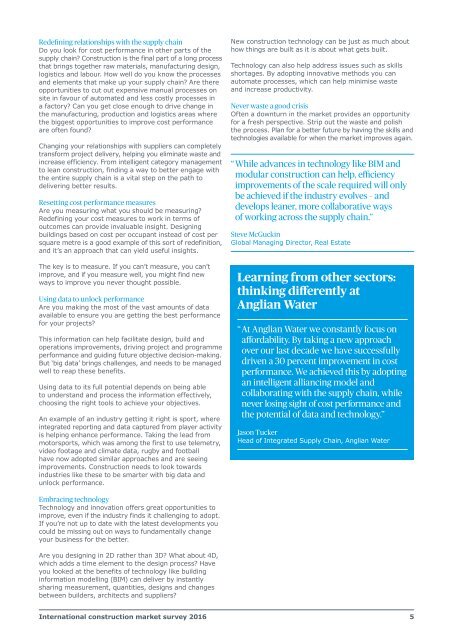International construction market survey 2016
ebP5dMy
ebP5dMy
Create successful ePaper yourself
Turn your PDF publications into a flip-book with our unique Google optimized e-Paper software.
Redefining relationships with the supply chain<br />
Do you look for cost performance in other parts of the<br />
supply chain? Construction is the final part of a long process<br />
that brings together raw materials, manufacturing design,<br />
logistics and labour. How well do you know the processes<br />
and elements that make up your supply chain? Are there<br />
opportunities to cut out expensive manual processes on<br />
site in favour of automated and less costly processes in<br />
a factory? Can you get close enough to drive change in<br />
the manufacturing, production and logistics areas where<br />
the biggest opportunities to improve cost performance<br />
are often found?<br />
Changing your relationships with suppliers can completely<br />
transform project delivery, helping you eliminate waste and<br />
increase efficiency. From intelligent category management<br />
to lean <strong>construction</strong>, finding a way to better engage with<br />
the entire supply chain is a vital step on the path to<br />
delivering better results.<br />
Resetting cost performance measures<br />
Are you measuring what you should be measuring?<br />
Redefining your cost measures to work in terms of<br />
outcomes can provide invaluable insight. Designing<br />
buildings based on cost per occupant instead of cost per<br />
square metre is a good example of this sort of redefinition,<br />
and it’s an approach that can yield useful insights.<br />
The key is to measure. If you can’t measure, you can’t<br />
improve, and if you measure well, you might find new<br />
ways to improve you never thought possible.<br />
Using data to unlock performance<br />
Are you making the most of the vast amounts of data<br />
available to ensure you are getting the best performance<br />
for your projects?<br />
This information can help facilitate design, build and<br />
operations improvements, driving project and programme<br />
performance and guiding future objective decision-making.<br />
But ‘big data’ brings challenges, and needs to be managed<br />
well to reap these benefits.<br />
Using data to its full potential depends on being able<br />
to understand and process the information effectively,<br />
choosing the right tools to achieve your objectives.<br />
An example of an industry getting it right is sport, where<br />
integrated reporting and data captured from player activity<br />
is helping enhance performance. Taking the lead from<br />
motorsports, which was among the first to use telemetry,<br />
video footage and climate data, rugby and football<br />
have now adopted similar approaches and are seeing<br />
improvements. Construction needs to look towards<br />
industries like these to be smarter with big data and<br />
unlock performance.<br />
New <strong>construction</strong> technology can be just as much about<br />
how things are built as it is about what gets built.<br />
Technology can also help address issues such as skills<br />
shortages. By adopting innovative methods you can<br />
automate processes, which can help minimise waste<br />
and increase productivity.<br />
Never waste a good crisis<br />
Often a downturn in the <strong>market</strong> provides an opportunity<br />
for a fresh perspective. Strip out the waste and polish<br />
the process. Plan for a better future by having the skills and<br />
technologies available for when the <strong>market</strong> improves again.<br />
“ While advances in technology like BIM and<br />
modular <strong>construction</strong> can help, efficiency<br />
improvements of the scale required will only<br />
be achieved if the industry evolves – and<br />
develops leaner, more collaborative ways<br />
of working across the supply chain.”<br />
Steve McGuckin<br />
Global Managing Director, Real Estate<br />
Learning from other sectors:<br />
thinking differently at<br />
Anglian Water<br />
“ At Anglian Water we constantly focus on<br />
affordability. By taking a new approach<br />
over our last decade we have successfully<br />
driven a 30 percent improvement in cost<br />
performance. We achieved this by adopting<br />
an intelligent alliancing model and<br />
collaborating with the supply chain, while<br />
never losing sight of cost performance and<br />
the potential of data and technology.”<br />
Jason Tucker<br />
Head of Integrated Supply Chain, Anglian Water<br />
Embracing technology<br />
Technology and innovation offers great opportunities to<br />
improve, even if the industry finds it challenging to adopt.<br />
If you’re not up to date with the latest developments you<br />
could be missing out on ways to fundamentally change<br />
your business for the better.<br />
Are you designing in 2D rather than 3D? What about 4D,<br />
which adds a time element to the design process? Have<br />
you looked at the benefits of technology like building<br />
information modelling (BIM) can deliver by instantly<br />
sharing measurement, quantities, designs and changes<br />
between builders, architects and suppliers?<br />
<strong>International</strong> <strong>construction</strong> <strong>market</strong> <strong>survey</strong> <strong>2016</strong> 5


